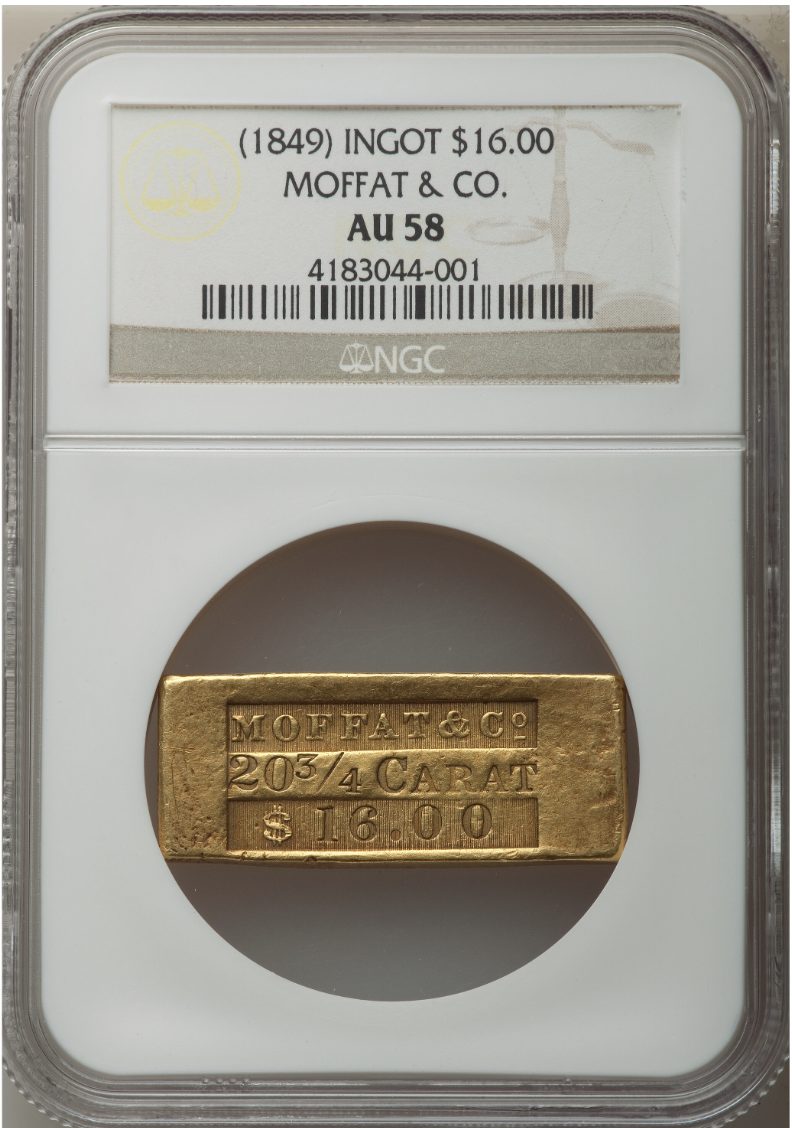Among the earliest and most successful private gold assayers and smelters during the California Gold Rush was Moffat & Company, headed by John Little Moffat of New York State. Moffat had previously worked in the gold fields of North Carolina and Georgia, and he came to California well-prepared to serve the miners who needed to have their gold dust weighed, evaluated, and converted into bars or ingots.
Departing from New York by ship in February 1849, Moffat brought with him three assistants, later partners in his company; along with the tools and machinery needed in order to carry out his smelting and assaying activities.
Arriving in California in June, 1849, Moffat and his three associates wasted no time in getting their new enterprise operational. They placed advertisements in two California newspapers on June 21, announcing their new smelting and assaying operation. These advertisements included endorsements from several prominent firms and individuals, including no less a personage than the Secretary of the United States Treasury, R.J. Walker.
(1849) Moffat & Co. Gold Ingot $16.00, K-3, AU58
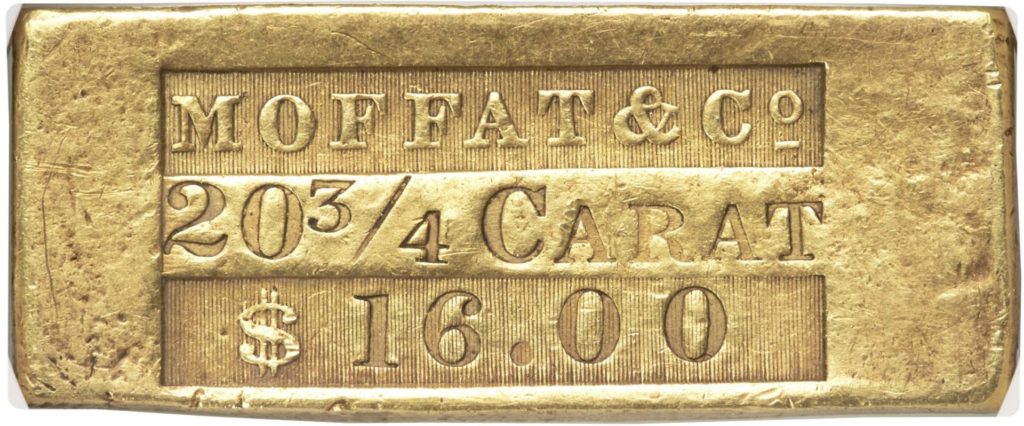

(1849) $16 Moffat & Co. 16 Dollar Ingot AU58 NGC. K-3, High R.6.
The small rectangular gold ingots that Moffat & Company produced, including the present piece, must have been made shortly after the opening of their business. By late August, the company was engaged in the minting of gold coins, after procuring the services of George Albrecht Ferdinand Kuner, recently arrived from New York, as their chief engraver. Apparently produced in denominations ranging from $9.43 to $264, few of the ingots still exist. Probably only 15 to 20 of the $16.00 ingots survive.
This example appears to have circulated very little, as indicated by the near-Mint grade assessment by NGC. The stamp is boldly impressed and nearly centered on the small rectangular ingot. The lettering reads:
MOFFAT & Co
20 3/4 CARAT
$16.00
Wispy, shallow marks are noted mainly on the blank reverse, and most are undoubtedly minor imperfections that were on the “planchet” prior to the striking process.
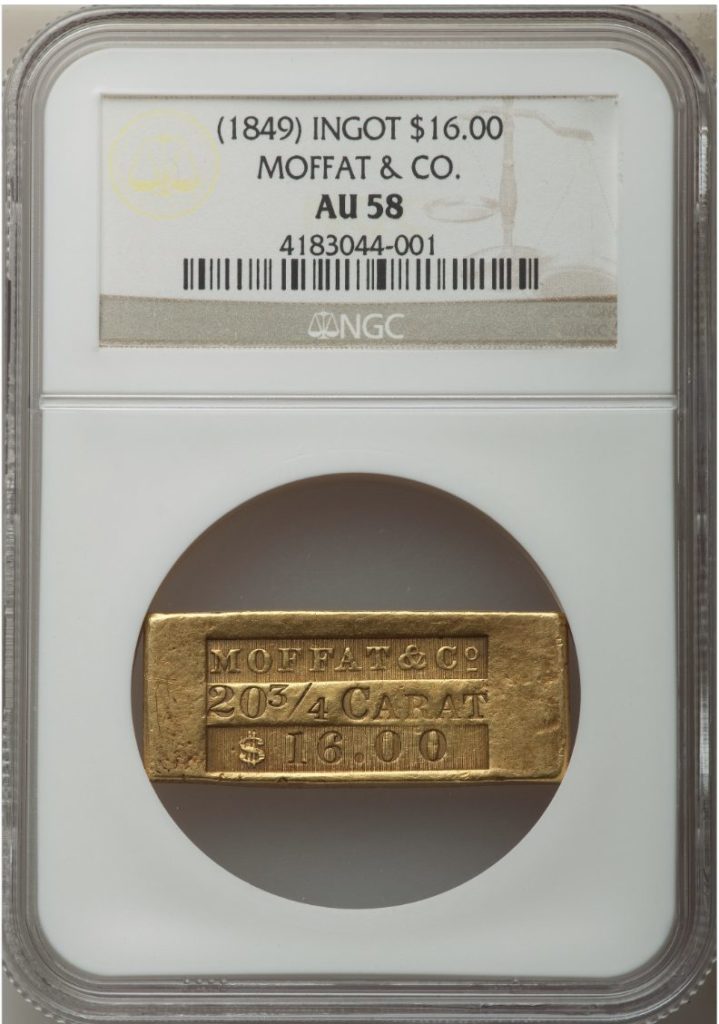
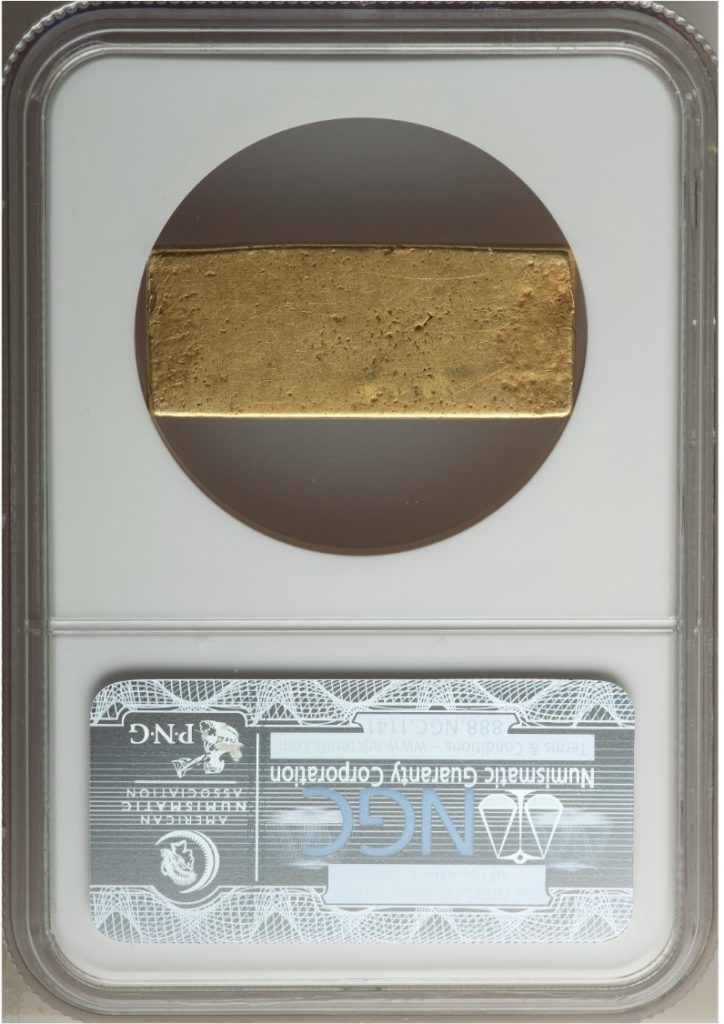
A rare and high-grade gold ingot, one of only two at this grade level certified at NGC (11/21). Listed on page 396 of the 2022 Guide Book.
Ex: Long Beach Signature (Heritage, 6/2014), lot 5016, where it brought $199,750.
From The Buffalo Bayou Collection of Territorial Gold.
[01/2022] https://coins.ha.com/itm/territorial-gold/-1849-16-moffat-and-co-16-dollar-ingot-au58-ngc-k-3-high-r6-pcgs-10253-/a/1341-4461.s ($384,000)
Moffat & Co. $16 Ingot, undated (1849)

A beautiful Extremely Fine example.
Moffat & Co. issued numerous bars of the $16 denomination, this being the value in commerce of one ounce of gold at the time. Thus an ingot or bar of this type formed a convenient medium of exchange. The front of the bar is impressed by a prepared punch with a vertically ribbed background. At the top is the inscription MOFFAT & CO. Below, a prepared punch originally consisting of a raised dollar sign ($) with a blank vertically ribbed background (blank until the value is added). On this particular ingot the valuation 16.00 was punched in after the dollar sign. In the center, between the two prepared punches, the fineness 20 3/4 CARAT was added. The sides and reverse are blank. The left edge of the bar bears a circular raised mark of unknown origin. Perhaps it was a “stem” used when the ingot was originally cast. Compare this piece to Garrett No. 927 with the same features, for example.
The $16 valuation is the “classic” California gold dust. It has been estimated that perhaps a total of 20 to 25 examples exist, some of which are impounded in museums. Long intervals often elapse between appearances. A marvelous opportunity for the collector of western numismatic Americana. ($15,000-20,000)
Obtained from New Netherlands Coin Co., 1970.
This very same ingot later resurfaced in the “The Old West and Franklinton Collections” sale by American Numismatic Rarities, 2006.

A superb example of this famous and elusive artifact of the early days of the California Gold Rush, plated in both Don Kagin’s standard work on territorial pieces and in Walter Breen’s Encyclopedia. Pleasing rich, even yellow gold with superb surface quality and visual appeal. The stamp is extremely bold throughout, a bit farther from the baseline of the ingot at the lower right corner than at the lower left. The ingot is well made, its casting sprue or “stem” is faintly visible on the right edge as made, and a natural cooling depression may be seen on the reverse at the same edge. Very little post-striking handling is seen, and this piece appears to have circulated very little, as indicated by the PCGS-assigned grade. Scattered light marks are seen, many undoubtedly from the time of production and natural unevenness in the never-rolled metal, and only a minor shallow scrape just right of the punched area serves as a clear identifier on that side. Two tiny rim nicks at the base of the reverse and some faint hairlines on that blank side are also noted. The baseline has a faint natural curvature, and the central reverse shows the typical light granularity caused at the moment the obverse was struck. The quality of this Moffat ingot is superb for the issue, showing few flaws and excellent original production character.
An important bridge between the world of round coins and rectangular assay ingots, the Moffat ingots served as circulating currency items and as such have always seen avid collector interest. A specimen of this issue turned up at the British Numismatic Society in London at their meeting of November 22, 1849, mere months after initial production. Another found its way into the Mint Cabinet as early as 1850, now at the Smithsonian. Two unique Moffat ingots were later given to the Smithsonian Institution as part of the Lilly Collection, one denominated $14.25 and the other issued as $9.43. All others known today were issued as $16 pieces, equal to
a Latin American eight escudos or “doubloon,” the highest value circulating coin of the realm until the issuance of $20 pieces
(March 1850 for Federal coins, September 1849 for the overvalued Mormon coins). Eight escudo coins were legal tender until 1857 and circulated even later, so the $16 denomination — though seemingly odd among modern coins — would have been comfortable and sensible to the people of the era.
These monetary ingots contrasted sharply with the non-standard ingots issued by many assayers across California and, later, elsewhere in the American West. The denomination of the Moffat $ 16 monetary ingots was fixed at a known and easy-to-handle value, very different from the unwieldy and irregularly denominated ingots like those found on the S.S. Central America, which were produced as an easy way to transport the valuable metal, as opposed to being made especially for daily commerce. Produced beginning in early summer 1849, likely June of that year, they stand as the earliest California Cold Rush “coins” produced with the lone exception of the Norris, Cregg, and Norris $5 which was first coined only a few weeks earlier. The stated fineness of the Moffat ingots is 20 3/4 karat or .865 fine, closely resembling that of native California gold, though undoubtedly the actual fineness varied somewhat; the Norris pieces were said to have been struck from “California gold without alloy” yet tests on their fineness at the time yielded a range from .870 fine to .892 fine. Other coinage of 1849 was in the same range.
Territorial coins from the Days of ‘49 are a scarce breed, and few are as historic and as rare as a Moffat $16 ingot. Perhaps a total population of 15 or 20 specimens survive, most showing evidence of handling and circulation. Western ingots have undergone a renaissance of appreciation since the dispersal of the treasure of the S.S. Central America, and their role in the commercial economy of the Cold Rush is now much better understood. It is important to note that despite the profusion ot coins and ingots on the famed “Ship of Gold,” not a single Moffat $ 16 ingot was among the treasure; it is likely that in the eight years between their production and the loss of that wreck few, if any, were still in circulation, and those that survive exist purely by chance. We also note that since the time of the Central America treasure’s dispersal, there appear to have been no Moffatt ingots offered at public auction, the last sale being the 2000 offering of the Eliasberg ingot in Bowers and Merena’s sale. The aftermarket for small currency-style Central America ingots has been kind to the original purchasers, and we foresee a similar increase in the appreciation of this rare golden artifact as well.
PCGS Population: 4; 2 finer (both AU-58). Only eight total specimens have been certified by PCGS.
Thanks to Denis Loring for offering previously unpublished information on this issue.
Purchased from New Netherlands Coin Company ca. 1970; Bowers and Ruddy’s sale of the Henry Clifford Collection, March 1982, Lot 83; Bowers and Merena ’s sale of the A mold and Romisa Collections, September 1984, Lot 307 (at $17,600).
[03/1982] https://archive.org/details/henryhcliffordco1982bowe/page/n63
[08/2006] https://archive.org/details/oldwestfranklint2006amer/page/250/
(1849) $9.43 Moffat & Co.

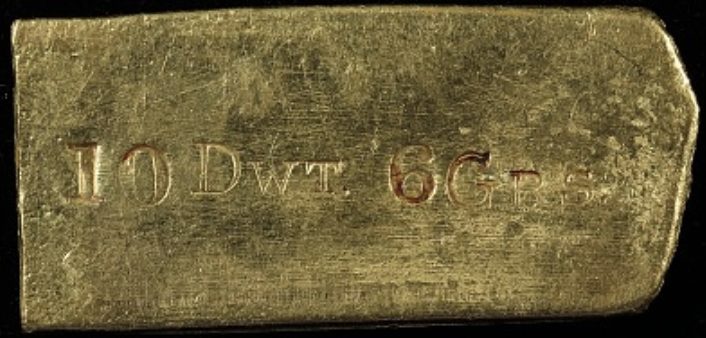
Obverse Text: MOFFAT & CO / 21 7/16 CARAT / $9.43
Reverse Text: 10 DWT. 6 GRS.
Currently housed at the Smithsonian Institution.
See: https://americanhistory.si.edu/collections/nmah_1101833
(1849) $14.25 Moffat & Co.
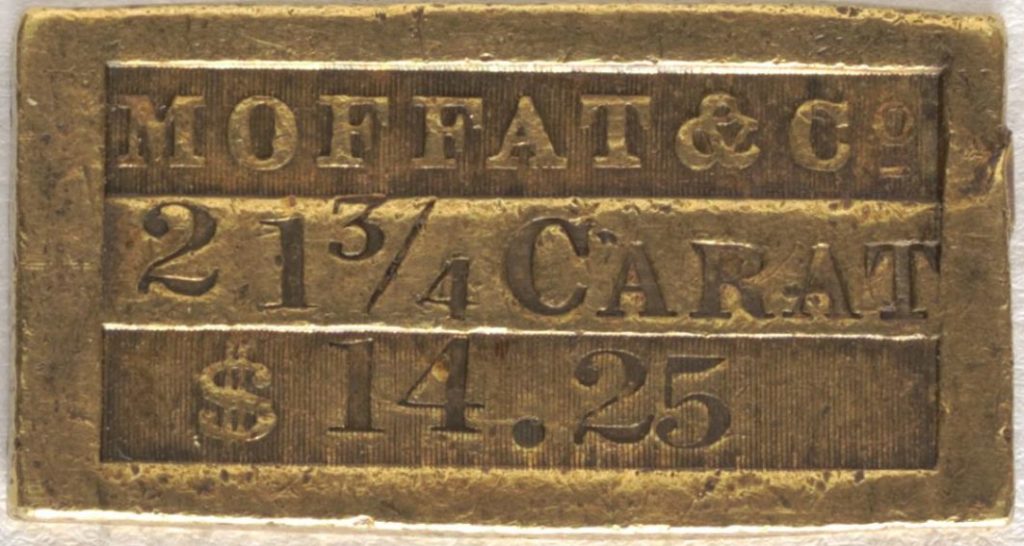
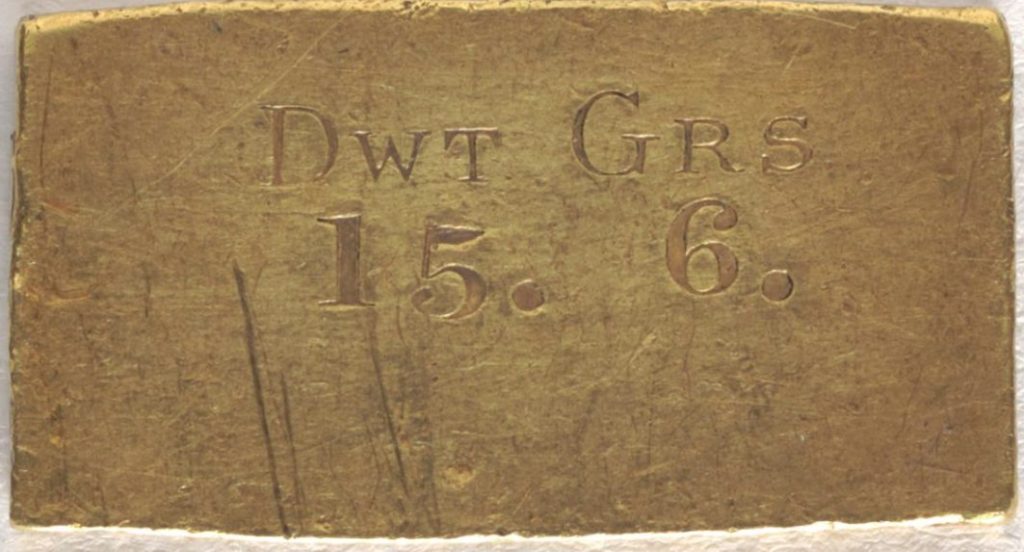
Obverse Text: MOFFAT & CO / 21 3/4 CARAT / $14.25
Reverse Text: 15 DWT. 6 GRS.
Currently housed at the Smithsonian Institution.
See: https://americanhistory.si.edu/collections/nmah_1101835
If you like Moffat & Co, then the unique Meyers $18 ingot should be even more interesting to read about here:

